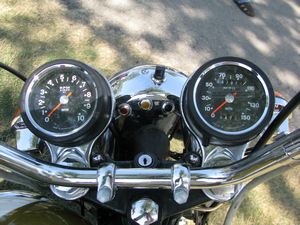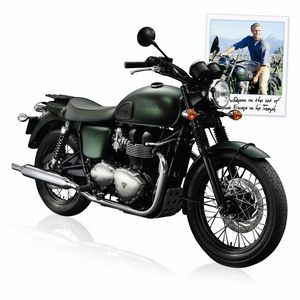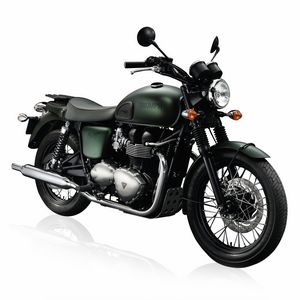















Triumph Bonneville |
|---|

|
| External Links |
|---|
| Wikipedia: Triumph Bonneville |
| Page Sections |
|
History
Photographs Article Index |
History
The following section is an excerpt from Wikipedia's Triumph Bonneville page on 27 July 2016, text available via the Creative Commons Attribution-ShareAlike 3.0 Unported License.
The Triumph Bonneville is a standard motorcycle featuring a parallel-twin four-stroke engine and manufactured in three generations over three separate production runs.
The first two generations, by the defunct Triumph Engineering in Meriden, West Midlands, England, were 1959-1983 and 1985-1988.
The third series, by Triumph Motorcycles in Hinckley, Leicestershire, began in 2001 and continues to the present (2015) as a completely new design that strongly resembles the original series.
The name Bonneville derives from the famous Bonneville Salt Flats, Utah, USA where Triumph and others attempted to break the motorcycle speed records.
T120 Bonneville
The original Triumph Bonneville was a 650 cc parallel-twin motorcycle manufactured by Triumph Engineering and later by Norton Villiers Triumph between 1959 and 1974. It was based on the company's Triumph Tiger T110 and was fitted with the Tiger's optional twin 1 3/16 in Amal monobloc carburettors as standard, along with that model's high-performance inlet camshaft. Initially it was produced with a pre-unit construction engine which enabled the bike to comfortably achieve 115 mph without further modification, but later in 1963 a unit construction model was introduced which was stiffer and more compact, including additional bracing at the steering head and swing arm. The steering angle was altered and improved forks were fitted a couple of years later, which, together with the increased stiffness enabled overall performance to match that of the Bonneville's rivals. Later T120 Bonnevilles used a new frame which contained the engine oil instead of using a separate tank; this became known as the oil in frame version. The T120 engine, both in standard configuration and especially when tuned for increased performance, was popular in café racers such as Tribsas (BSA frame) and particularly Tritons (Norton featherbed frame).
T140 Bonneville
The early 650 cc T120 Bonneville, often known as the duplex frame model, was replaced in the early 1970s by the T140 Bonneville, the same basic machine but with a 750 cc engine. Refined from the later 'oil in frame' version of the T120, the first few T140s, designated T140V, featured a larger-capacity engine of 724 cc, a five-speed gearbox option and indicators, but still retaining drum brakes and kick-start. Shortly after, the engine was further bored out to 744 cc and front disc brakes were fitted using single discs until 1982. In 1975, along with engine modifications, the gearchange lever was moved from right to left to comply with new regulations mandated for the American market and a rear disc brake fitted. Several T140 models followed featuring various modifications and refinements including electric starting from 1980 until production ceased with the closure of the Meriden works in 1983.
Although this should have been the end of the Bonneville, as it turned out it was not. Triumph Motorcycles was acquired by businessman John Bloor, who licensed a company called Racing Spares in Devon, run by Les Harris to manufacture the T140 Bonneville. These continuation bikes are known as the 'Devon Bonnevilles', which did not reach the market until 1985, and were not sold in the U.S. Production ended in 1988.
New Bonneville (800, 900 & 1200)
Bloor's Triumph Motorcycles Ltd launched a completely new model, the Bonneville 800 (790cc), in September 2001. Originally built exclusively in Hinckley, England, some models are now (2014) produced at the company's Thailand manufacturing facility, which also makes components and accessories for various Triumph motorbikes. The new Bonneville strongly resembles the earlier models in style and basic configuration, but with modern engineering. At the debut the new version was given a 790 cc parallel-twin engine, with the up-spec T100 receiving an 865 cc engine. From 2007 on, all Bonnevilles received the 865 cc engine. Through 2007, all engines had carburettors; electronic fuel injection (EFI) was then introduced to the 2008 models in Britain and to United States models in the 2009 model year, in both cases to comply with increasingly stringent emissions requirements. Dummy carburettors, which are actually redesigned throttle bodies made to resemble carburettors, have been added to the 2009 models to retain the original vintage styling of previous years. In 2015, Triumph introduced a 1200 version of the Bonneville to complement the 900 range.
From 2008, all Bonnevilles received a slightly larger and reshaped tank to accommodate the EFI pump, but the tank capacity was not altered. Even though US 2008 models were not injected they still received the larger tank, therefore the space for the pump was not used.
All the bikes in Triumph's current "Modern Classics" line are derived from the new Bonneville, including the SE, T100, Thruxton, Scrambler, America, and Speedmaster.
In 2006, Triumph launched the "Sixty-8" line of Bonneville accessories, offering vintage and modern-style items including seats, seat covers, cam covers, sprocket covers, petrol tank covers, tank badges, panniers, and other items to allow Bonneville owners the opportunity to customise their bikes for considerably less cost than traditional customisations. The adoption of the EFI engine in 2008 rendered many of these accessories obsolete, since tank covers, tank badges etc. would not fit the redesigned tank.
The original T120 Bonneville was a speed-orientated motorcycle, but the new Bonnevilles are softer and aimed at the roadster market. In particular, the 865cc Bonneville competes directly with the Harley-Davidson 883; and MotorCycle News declares that "Triumph Bonneville is unquestionably the better motorcycle. The handling is more than respectable, the brakes markedly better and, of course, it’s British."
Models: T120 Bonneville
T120: Home and general export model.
T120R: Export model for the United States of America.
T120C: Export competition model with high-level exhaust pipes.
T120TT: 1964 export dirt track racing model of the T120C for the U.S. East Coast. 'Thruxton' models were factory homologated road racing models, to special order.
T120RV: Five-speed gearbox.
T120V: Five-speed gearbox with front disk brake.
T140V: The initial model of the T140. The 'V' indicated a five-speed gearbox. Produced between 1972 and 1978.
T140RV: Export version of T140V.
T140J: Limited edition of 1,000 each (plus 400 for Commonwealth export) of the T140V in USA and UK specification, produced to commemorate the 1977 Silver Jubilee of Elizabeth II.
T140E: The letter 'E' stood for emissions, enabling export to the USA market. This model featured redesigned Amal carburetors soon replaced by, Lucas electronic ignition to meet emission regulations.
T140D: Limited edition. T140D offered with Lester, later Morris, cast wheels in black/gold scheme only. The US version had a special siamesed exhaust system unique to this model. The 'D' stood for Daytona, USA, where the model was conceived.
T140ES: Electric start or 'Electro' Bonneville.
T140AV: Anti-vibration engine mountings.
T140LE: Limited Edition. 250 'Royal' Bonnevilles were built to commemorate the 1981 marriage of Lady Diana Spencer and Prince Charles.
T140W TSS: The Triumph T140W TSS. Introduced 1982. Eight-valve cylinder head and revised crankshaft to reduce vibration. The TSS stood for 'Triumph Super Sports'.
T140TSX: A custom-styled T140, the Triumph T140 TSX featured Morris cast wheels, the rear being 16-inch diameter, stepped seat and special finish.
Harris T140: Built under license 1985 to 1988 by Les Harris after the Meriden factory closed and featuring significantly more Italian and German component parts.
Bonneville 790: Introduced 2000. Original 790 cc model
Bonneville: Current (2014) baseline model. In 2009 the baseline model gained cast alloy wheels, tank badge in decal form, black engine covers and up-swept megaphone exhaust silencers
Bonneville Black: 2004 to 2008. Variation on baseline model with black paint and introducing the black engine covers subsequently used across the family from 2004, except on the Speedmaster, SE and T100.
Bonneville SE: Introduced 2009. Uprated model still with black engine, cast alloy wheels and upswept megaphone exhaust silencers, but with traditional metal tank badge, polished alloy engine covers and ‘shortie’ mudguards. Available with two-tone colour scheme
T100: Top-of-the-range model with spoked wire wheels, fork gaiters, two-tone tank colour scheme, twin ‘peashooter’ exhausts, chromed engine covers, Triumph logo on seat,
Thruxton: Introduced 2004. Redesigned Bonneville with 60s café racer styling. First model with the larger 865 cc engine.
Scrambler: Introduced 2006. Redesigned Bonneville with off-road styling of the T100C version of the Triumph Tiger 100, the TR6C, and the Triumph Trophy Trail (TR5T). .
America: Semi-cruiser styled model with lengthened wheelbase, lowered saddle. Primarily intended for the United States of America.
Speedmaster: 'Factory custom' cruiser based on the Triumph Bonneville America.
 |
Subject: 1972 Triumph Bonneville
Photographer: Bill Crittenden Event: 2012 The Cars Time Forgot 
View photo of 1972 Triumph Bonneville - 5.1MB |
 |
Subject: 1972 Triumph Bonneville
Photographer: Bill Crittenden Event: 2012 The Cars Time Forgot 
View photo of 1972 Triumph Bonneville - 4.5MB |
 |
Subject: 1972 Triumph Bonneville
Photographer: Bill Crittenden Event: 2012 The Cars Time Forgot 
View photo of 1972 Triumph Bonneville - 5.0MB |
 |
Subject: Triumph Bonneville T100 Steve McQueen Special Edition
Source: Firebox View photo of Triumph Bonneville T100 Steve McQueen Special Edition - 1.3MB |
 |
Subject: Triumph Bonneville T100 Steve McQueen Special Edition
Source: Firebox View photo of Triumph Bonneville T100 Steve McQueen Special Edition - 1.1MB |
| Date | Article | Author/Source |
|---|---|---|
| 14 December 2015 | Custom British Customs X CROIG Triumph Bonneville Motorcycle Giveaway to Raise Awareness for Riders for Health Charity | British Customs |
